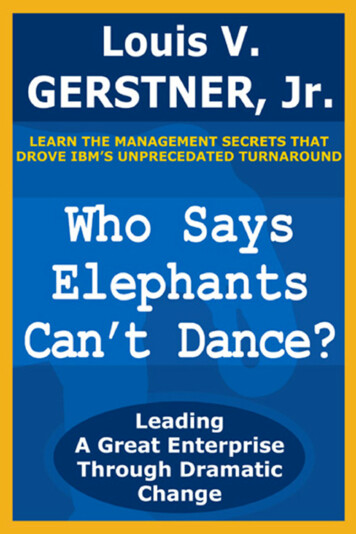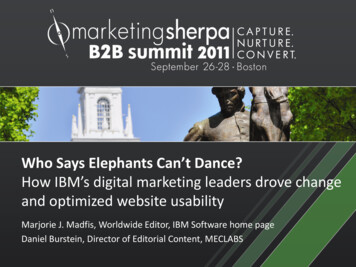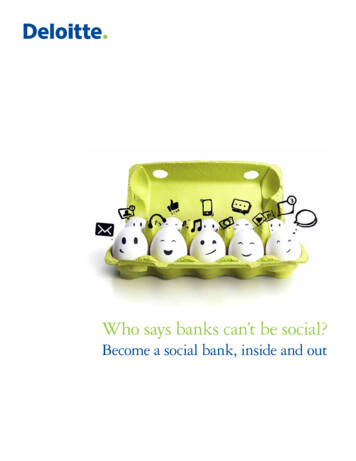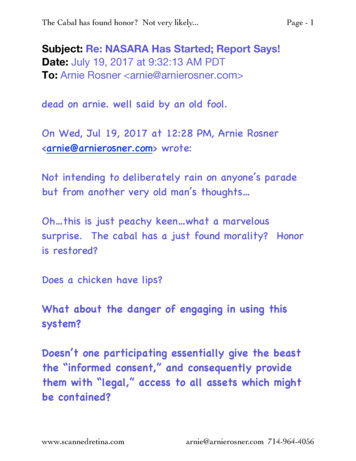
Transcription
Who Says ElephantsCan’t Dance?Leading a GreatEnterprise ThroughDramatic ChangeLouis V.Gerstner, Jr.
This book is dedicated to the thousands of IBMers who never gaveup on their company, their colleagues, and themselves. They are thereal heroes of the reinvention of IBM.
ContentsForewordviiIntroduction1PART I-GRABBING HOLD71 The Courtship92 The Announcement183 Drinking from a Fire Hose294 Out to the Field415 Operation Bear Hug496 Stop the Bleeding (and Hold the Vision)567 Creating the Leadership Team738 Creating a Global Enterprise839 Reviving the Brand8810 Resetting the Corporate Compensation Philosophy11 Back on the Beach93103
PART II-STRATEGY11112 A Brief History of IBM11313 Making the Big Bets12114 Services—the Key to Integration12815 Building the World’s Already Biggest Software Business13616 Opening the Company Store14617 Unstacking the Stack and Focusing the Portfolio15318 The Emergence of e-business16519 Reflections on Strategy176PART III-CULTURE17920 On Corporate Culture18121 An Inside-Out World18922 Leading by Principles200PART IV-LESSONS LEARNED21723 Focus—You Have to Know (and Love) Your Business21924 Execution—Strategy Goes Only So Far22925 Leadership Is Personal23526 Elephants Can Dance24227 IBM—a Farewell253APPENDICES259Appendix A—The Future of e-business261Appendix B—Financial Overview277Index287
ABOUT THE AUTHORCREDITSCOVERCOPYRIGHTABOUT THE PUBLISHER
ForewordIhave never said to myself, “Gee, I think I want to write abook.” I am not a book writer. Until now I haven’t had thetime or the inclination to lean back and reflect on my thirty-fiveyears in business. I haven’t had the patience it takes to sit down fora long time and create a book. Throughout my business life I havebeen wary of telling others how to manage their enterprises basedon my personal experiences.And, frankly, I wasn’t sure if anyone would be interested inreading my thoughts. I read a lot of books, but not many aboutbusiness. After a twelve-hour day at the office, who would want togo home and read about someone else’s career at the office?I have always believed you cannot run a successful enterprisefrom behind a desk. That’s why, during my nine years as Chief Executive Officer of International Business Machines Corporation, Ihave flown more than I million miles and met with untold thousandsof IBM customers, business partners, and employees. Over the pasttwo years, after people began speculating that my retirement mightbe just around the corner, I thought I’d get a lot of big-picturequestions that outgoing CEOs get about the economy, the world, andthe future. Instead, I have been surprised by how many times—atbig meetings and small ones, and even at private sessions with CEOsand heads of state—I was asked: “How did you save IBM?” “Whatwas it like when you got there?” “What were the problems?” “Whatspecific things did
viii / LOUIS V. GERSTNER, JR.you do to bring the company back to life?” “What did you learnfrom the experience?”They wanted to know, many of them said, because their owncompanies, organizations, or governments faced some of the sameissues IBM had encountered during its very, very public near collapsein the early 1990s. Businesspeople outside the United States, confronted with the need to transform tradition-bound enterprises intotough and nimble players in a world economy, seemed particularlyinterested in the subject.More recently, after I had announced my intention to retire, I wasamused to read an editorial in an American newspaper, USA Today,that said, in effect, it hoped Gerstner was going to do somethingmore useful than write a book and play golf. Nice thought, but sincethe announcement, I got thousands of letters and e-mails, and themost frequent sentiment was, again, that I should tell what I hadlearned from my tenure at IBM. (I was also invited to appear in a TVcommercial with golf pros Jack Nicklaus and Gary Player.) Youmight say that I concluded, a little reluctantly, that the easiest wayfor me to fulfill all this “popular demand” was to write a book andto hold off on serious golf for the time being.So, here I am, ready to tell you the story of the revival of IBM.Of course, this book would never have appeared without the heroes among my IBM colleagues who helped me restore IBM to a position of leadership. In many respects this is their book as much as itis mine. There were many such leaders, but clearly among the mostimportant were Dennie Welsh and Sam Palmisano, who built ourservices company; John Thompson, who created our Software Group;Abby Kohnstamm, who took a cacophony of confused messagesand melded them into one of the most powerful brand statementsin the world; Nick Donofrio, who was my translator from the worldof high tech to the world of management; Jerry York, Rick Thoman,and John Joyce, three great financial executives who instilled a levelof productivity, discipline, and probing analysis into a companythat
WHO SAYS ELEPHANTS CAN’T DANCE? / ixappeared to value these quite lightly when I arrived; Larry Ricciardi,my colleague of many years, who brought his intellect and counselto many of our critical decisions; and, finally, Tom Bouchard, whoas head of Human Resources stood tall and took the heat as wetransformed the IBM culture.There are many more. In fact, there are thousands of IBMers whoanswered the call, put their shoulders to the wheel, and performedmagnificently as we undertook an exhausting—at times frightening,but always exhilarating—journey to restore this extraordinarycompany. To all of them, I dedicate this book.I wrote this book without the aid of a coauthor or a ghostwriter(which is why it’s a good bet this is going to be my last book; I hadno idea it would be so hard to do). I am responsible for any mistakesor confusion the reader may endure. The views expressed are mineand are not necessarily those of the IBM Corporation or any otherIBMer.I did have a great deal of help from some longtime IBM colleagues.They include Jon Iwata, Mark Harris, and Mike Wing, who madesubstantial contributions. Michele Andrle managed production ofevery draft and redraft deftly and patiently—an unbelievable amountof stitching and restitching. I want to thank them and everyone elsewho helped me.
IntroductionThis is not my autobiography. I can’t think of anyone otherthan my children who might want to read that book (andI’m not 100 percent sure they would, either). However, in the spiritof trying to provide some contextual background for my views, whatfollows is a brief historical perspective.I was born on March 1, 1942, in Mineola, New York—the countyseat of Nassau County, Long Island.My father started work as a milk-truck driver and ultimately became a dispatcher at the F&M Schaeffer Brewing Company. Mymother was a secretary, sold real estate, and eventually became anadministrator at a community college. Along with three brothers—one older, two younger—I lived in the same house in Mineolauntil I left for college, in 1959.We were a warm, tightly knit, Catholic, middle-class family.Whatever I have done well in life has been a result of my parents’influence. My father was a very private man with a great love oflearning and inner strength that needed no approbation or reinforcement from broader audiences. My mother was enormously disciplined, hard-working, and ambitious for all her children. She droveus toward excellence, accomplishment, and success.Education was a high priority in the Gerstner household. Myparents remortgaged their house every four years to pay forschooling. I attended public grade school, then Chaminade, a Catholic high school in Mineola. I graduated in 1959 and was almost onmy way to
2 / LOUIS V. GERSTNER, JR.Notre Dame when Dartmouth College offered me a substantialscholarship. It was a major benefit for our family finances, so I packedoff for Dartmouth in September 1959, without ever having set footon its campus.Four years later I graduated with a degree in engineering science.I immediately went to Harvard Business School for two years. (Backthen one could leave undergraduate school and go directly to business school, a practice that has since, for the most part, been abandoned by business schools.)Then, at the tender age of 23, I emerged from Harvard and wentinto business.I joined the management consulting firm of McKinsey & Companyin New York City in June 1965. My first assignment was to conductan executive compensation study for the Socony Mobil Oil Co. I’llnever forget my first day on that project. I knew nothing about executive compensation, and absolutely nothing about the oil industry.Thank goodness I was the low man on the totem pole, but in theMcKinsey world one was expected to get up to speed in a hurry.Within days I was out meeting with senior executives decades olderthan I was.Over the next nine years I advanced to the level of senior partnerat McKinsey. I was responsible for its finance practice and was amember of its senior leadership committee. I was the partner incharge of three major clients, two of which were financial servicescompanies.The most important thing I learned at McKinsey was the detailedprocess of understanding the underpinnings of a company. McKinseywas obsessive about deep analysis of a company’s marketplace, itscompetitive position, and its strategic direction.When I reached my early thirties, it became clear to me that Ididn’t want to stay in consulting as a career. Although I enjoyed theintellectual challenge, the fast pace, and the interaction with topranking senior people, I found myself increasingly frustrated playingthe role of an advisor to the decision makers. I remember saying to
WHO SAYS ELEPHANTS CAN’T DANCE? / 3myself, “I no longer want to be the person who walks into the roomand presents a report to a person sitting at the other end of the table;I want to be the person sitting in that chair—the one who makes thedecisions and carries out the actions.”Like many other successful McKinsey partners, I had gotten anumber of offers to join my clients over the years, but none of theproposals seemed attractive enough to make me want to leave. In1977, however, I received and accepted an offer from American Express, which was my largest client at that time, to join it as the headof its Travel Related Services Group (basically, the American ExpressCard, Traveler’s Checks, and Travel Office businesses). I stayed atAmerican Express for eleven years, and it was a time of great funand personal satisfaction. Our team grew Travel Related Servicesearnings at a compounded rate of 17 percent over a decade; expandedthe number of cards issued from 8 million to nearly 31 million, andbuilt whole new businesses around the Corporate Card, merchandisesales, and credit card processing industries.I also learned a great deal. Early on I discovered, to my dismay,that the open exchange of ideas—in a sense, the free-for-all ofproblem solving in the absence of hierarchy that I had learned atMcKinsey—doesn’t work so easily in a large, hierarchical-based organization. I well remember stumbling in my first months when Ireached out to people whom I considered knowledgeable on a subjectregardless of whether they were two or three levels down from mein the organization. My team went into semi-revolt! Thus began alifelong process of trying to build organizations that allow for hierarchy but at the same time bring people together for problem solving,regardless of where they are positioned within the organization.It was also at American Express that I developed a sense of thestrategic value of information technology. Think about what theAmerican Express Card represents. It is a gigantic e-business, although we never thought about it in those terms in the 1970s. Millions of people travel the world with a sliver of plastic, charginggoods and
4 / LOUIS V. GERSTNER, JR.services in many countries. Every month they receive a single billlisting those transactions, all translated into a single currency. Concurrently merchants are paid around the globe for transactionscompleted by hundreds, if not thousands, of people whom they donot know and may never see again. All of this is done for the mostpart electronically, with massive data processing centers worldwide.The technology imperative of this business was something I wrestledwith for many years.This was also when I first discovered the “old IBM.” I’ll neverforget the day one of my division managers called and said that hehad recently installed an Amdahl computer in a large data centerthat had historically been 100-percent IBM equipped. He said thathis IBM representative had arrived that morning and told him thatIBM was withdrawing all support for his massive data processingcenter as a result of the Amdahl decision. I was flabbergasted. Giventhat American Express was at that time one of IBM’s largest customers, I could not believe that a vendor had reacted with this degreeof arrogance. I placed a call immediately to the office of the chiefexecutive of IBM to ask if he knew about and condoned this behavior.I was unable to reach him and was shunted off to an AA (administrative assistant) who took my message and said he would pass iton. Cooler (or, should I say, smarter) heads prevailed at IBM and theincident passed. Nevertheless, it did not go out of my memory.I left American Express on April 1, 1989, to accept what some inthe media called at the time the “beauty contest” of the decade. RJRNabisco, a huge packaged-goods company that had been formed afew years earlier through the merger of Nabisco and R. J. ReynoldsTobacco Company, was rated the ninth-most-admired company inAmerica when the headhunters called me. The organization had justgone through one of the wildest adventures in modern Americanbusiness history: an extraordinary bidding contest among variousinvestment firms to take the company private through a leveraged
WHO SAYS ELEPHANTS CAN’T DANCE? / 5buyout (LBO). The winning bid was made by the venture capital firmof Kohlberg Kravis Roberts & Co. (KKR). Soon afterward, KKR soughtme out to become chief executive of the now private and heavilyindebted company.For the next four years I became immersed in a whole new set ofchallenges. While I understood well from my American Expressdays the ongoing demands of a consumer products company, I reallyspent most of my time at RJR Nabisco managing an extraordinarilycomplex and overburdened balance sheet. The LBO bubble of the1980s burst shortly after the RJR Nabisco transaction, sending a tidalwave of trouble over this deal. In hindsight, KKR paid too much forthe company, and the next four years became a race to refinance thebalance sheet, while trying to keep some semblance of order in themany individual businesses of the company. It was a wild scene.We had to sell 11 billion worth of assets in the first twelve months.We had debt that paid interest rates as high as 21 percent a year. Wehad lender and creditor committees galore and, of course, the cleanupfrom the profligate spending of the prior management. (For example,when I arrived we had thirty-two professional athletes on ourpayroll—all part of “Team Nabisco.”)That was a difficult time for me. I love building businesses, notdisassembling them. However, we all have an opportunity to learnin everything we do. I came away from this experience with a profound appreciation of the importance of cash in corporate performance—“free cash flow” as the single most important measure ofcorporate soundness and performance.I also came away with a greater sense of the relationship betweenmanagement and owners. I had experienced this at McKinsey, whichwas a private company owned by its partners. The importance ofmanagers being aligned with shareholders—not through risk-freeinstruments like stock options, but through the process of puttingtheir own money on the line through direct ownership of the company—became a critical part of the management philosophy Ibrought to IBM.
6 / LOUIS V. GERSTNER, JR.By 1992 it was clear to all that while RJR Nabisco itself was doingquite well, the LBO was not going to produce the financial returnsthe owners had expected. It was clear to me that KKR was headedfor the exit, so it made sense for me to do the same. This book, whichstarts on the next page, picks up my story from there.
PART 1Grabbing Hold
1The CourtshipOn December 14, 1992, I had just returned from one ofthose always well-intentioned but rarely stimulatingcharity dinners that are part of a New York City CEO’s life, includingmine as CEO of RJR Nabisco. I had not been in my Fifth Avenueapartment more than five minutes when my phone rang with a callfrom the concierge desk downstairs. It was nearly 10 P.M. The concierge said, “Mr. Burke wants to see you as soon as possible thisevening.”Startled at such a request so late at night in a building in whichneighbors don’t call neighbors, I asked which Mr. Burke, where ishe now, and does he really want to see me face to face this evening?The answers were: “Jim Burke. He lives upstairs in the building.And, yes, he wants very much to speak to you tonight.”I didn’t know Jim Burke well, but I greatly admired his leadershipat Johnson & Johnson, as well as at Partnership for a Drug-FreeAmerica. His handling of the Tylenol poisoning crisis years earlierhad made him a business legend. I had no idea why he wanted tosee me so urgently. When I called, he said he would come rightdown.When he arrived he got straight to the point: “I’ve heard that youmay go back to American Express as CEO, and I don’t want you todo that because I may have a much bigger challenge for you.” Therefer
10 / LOUIS V. GERSTNER, JR.ence to American Express was probably prompted by rumors thatI was going to return to the company where I had worked for elevenyears. In fact, in mid-November 1992, three members of the AmericanExpress board had met secretly with me at the Sky Club in NewYork City to ask that I come back. It’s hard to say if I was surprised—Wall Street and the media were humming with speculationthat then CEO Jim Robinson was under board pressure to step down.However, I told the three directors politely that I had no interest inreturning to American Express. I had loved my tenure there, but Iwas not going back to fix mistakes I had fought so hard to avoid.(Robinson left two months later.)I told Burke I wasn’t returning to American Express. He told methat the top position at IBM might soon be open and he wanted meto consider taking the job. Needless to say, I was very surprised.While it was widely known and reported in the media that IBM washaving serious problems, there had been no public signs of an impending change in CEOs. I told Burke that, given my lack of technicalbackground, I couldn’t conceive of running IBM. He said, “I’m gladyou’re not going back to American Express. And please, keep anopen mind on IBM.” That was it. He went back upstairs, and I wentto bed thinking about our conversation.The media drumbeat intensified in the following weeks. BusinessWeek ran a story titled “IBM’s Board Should Clean Out the CornerOffice.” Fortune published a story, “King John [Akers, the chairmanand CEO] Wears an Uneasy Crown.” It seemed that everyone hadadvice about what to do at IBM, and reading it, I was glad I wasn’tthere. The media, at least, appeared convinced that IBM’s time hadlong passed.The SearchOn January 26, 1993, IBM announced that John Akers had decidedto retire and that a search committee had been formed to con
WHO SAYS ELEPHANTS CAN’T DANCE? / 11sider outside and internal candidates. The committee was headedby Jim Burke. It didn’t take long for him to call.I gave Jim the same answer in January as I had in December: Iwasn’t qualified and I wasn’t interested. He urged me, again: “Keepan open mind.”He and his committee then embarked on a rather public sweepof the top CEOs in America. Names like Jack Welch of General Electric, Larry Bossidy of Allied Signal, George Fisher of Motorola, andeven Bill Gates of Microsoft surfaced fairly quickly in the press. Sodid the names of several IBM executives. The search committee alsoconducted a series of meetings with the heads of many technologycompanies, presumably seeking advice on who should lead theirnumber one competitor! (Scott McNealy, CEO of Sun Microsystems,candidly told one reporter that IBM should hire “someone lousy.”)In what was believed to be a first-of-its-kind transaction, the searchcommittee hired two recruiting firms in order to get the services ofthe two leading recruiters—Tom Neff of Spencer Stuart ManagementConsultants N.V., and Gerry Roche of Heidrick & Struggles International, Inc.In February I met with Burke and his fellow search committeemember, Tom Murphy, then CEO of Cap Cities/ABC. Jim made anemphatic, even passionate pitch that the board was not looking fora technologist, but rather a broad-based leader and change agent.In fact, Burke’s message was consistent throughout the wholeprocess. At the time the search committee was established, he said,“The committee members and I are totally open-minded about whothe new person will be and where he or she will come from. Whatis critically important is the person must be a proven, effectiveleader—one who is skilled at generating and managing change.”Once again, I told Burke and Murphy that I really did not feelqualified for the position and that I did not want to proceed anyfurther with the process. The discussion ended amicably and theywent
12 / LOUIS V. GERSTNER, JR.off, I presumed, to continue the wide sweep they were carrying out,simultaneously, with multiple candidates.What the Experts Had to SayI read what the press, Wall Street, and the Silicon Valley computervisionaries and pundits were saying about IBM at that time. All ofit certainly fueled my skepticism and, I believe, that of many of theother candidates.Most prominent were two guys who seemed to pop up everywhereyou looked, in print and on TV—Charles Morris and Charles Ferguson. They had written a book, Computer Wars, that took a grimview of IBM’s prospects. They stated: “There is a serious possibilitythat IBM is finished as a force in the industry. Bill Gates, the softwaretycoon whom everybody in the industry loves to hate, denies havingsaid in an unguarded moment that IBM ‘will fold in seven years.’But Gates may be right. IBM is now an also-ran in almost every majorcomputer technology introduced since 1980. Traditional big computers are not going to disappear overnight, but they are old technology, and the realm in which they hold sway is steadily shrinking.The brontosaurus moved deeper into the swamps when the mammals took over the forests, but one day it ran out of swamps.”Their book concluded that “the question for the present iswhether IBM can survive. From our analysis thus far, it is clear thatwe think its prospects are very bleak.”Morris and Ferguson wrote a longer, more technical, and evengrimmer report on IBM and sold it to corporations and institutionsfor a few thousand dollars per copy. Among others, it frightened anumber of commercial banks that were lenders to IBM.Paul Carroll, IBM’s beat reporter at The Wall Street Journal, published a book that year chronicling IBM’s descent. In it, he said: “Theworld will look very different by the time IBM pulls itself together—
WHO SAYS ELEPHANTS CAN’T DANCE? / 13assuming it can pull itself together—and IBM will never again holdsway over the computer industry.”Even The Economist—understated and reliable—over the span ofsix weeks, published three major stories and one lengthy editorialon IBM’s problems. “Two questions still hang over the company,”its editors wrote. “In an industry driven by rapid technologicalchange and swarming with smaller, nimbler firms, can a companyof IBM’s size, however organized, react quickly enough to compete?And can IBM earn enough from expanding market segments suchas computer services, software, and consulting to offset the horrifyingdecline in mainframe sales, from which it has always made most ofits money?“The answer to both questions may be no.”And, said the usually sober Economist, “IBM’s humiliation is alreadybeing viewed by some as a defeat for America.”The DecisionThe turning point in my thinking occurred over Presidents’ Dayweekend in February 1993. I was at my house in Florida, where Ilove to walk the beach, clearing and settling my mind. It’s verytherapeutic for me. During an hour’s walk each day that weekend,I realized that I had to think differently about the IBM situation. Whatprompted my change of heart was what was happening at RJRNabisco. As I noted in the Introduction, it had become clear that KKRhad given up on making its leveraged buyout work as planned.There were two reasons for this. First, as discussed in Bryan Burroughs and John Helyar’s book Barbarians at the Gate, in the fury andmadness of the bidding process in 1988, KKR overpaid for RJRNabisco. This meant that despite achieving all of the restructuringobjectives of the LBO, there simply wasn’t enough operating leverageto produce the projected returns. Second, the operating returns fromthe tobacco business were under pressure as a result of a price warstarted by Philip Morris soon after
14 / LOUIS V. GERSTNER, JR.the RJR Nabisco buy out. Philip Morris was simply following theadvice of Ray Kroc, founder of McDonald’s, who’d once said, “Whenyou see your competitor drowning, grab a fire hose and put it in hismouth.”KKR obviously was working on an exit strategy. As I walked thebeach that February, I decided I should be doing the same thing.And so, as much as anything else, the view that I would not be atRJR Nabisco too much longer was what got me thinking more aboutthe IBM proposal.I called Vernon Jordan, the Washington attorney who was alongtime friend as well as a director of RJR Nabisco, and asked hisadvice. He confirmed my feeling that KKR was ready to move outof RJR Nabisco and that this phase of the company’s tumultuous lifewas coming to an end. Also, it was clear that Jim Burke had alreadytalked with Vernon, because Vernon knew I was on the IBM list. Hisadvice was, as usual, to the point. He said, “IBM is the job you havebeen in training for since you left Harvard Business School. Go forit!”I suppose there was a second reason I changed my mind. I havealways been drawn to a challenge. The IBM proposition was dauntingand almost frightening, but it was also intriguing. The same wastrue of RJR Nabisco when I’d joined it in 1989. I think it is fair to saythat from February 15 on, I was prepared to consider taking on IBMand its problems. Vernon got word to Jim Burke that I might be inplay after all. I began to organize my questions and concerns forBurke and his committee.When Burke called later that week, I told him that I would take alook at the IBM job. I told him I would need a lot more information,particularly about the company’s short- and intermediate-termprospects. The dire predictions of the media and the pundits hadme worried. I had learned a hard lesson at RJR Nabisco: A companyfacing too many challenges can run out of cash very quickly.I told Burke that I wanted to meet with Paul Rizzo. Paul had beenan executive at IBM in the 1980s. I had met him on several occa
WHO SAYS ELEPHANTS CAN’T DANCE? / 15sions and admired him greatly. He had retired from IBM in 1987 buthad been called back by the IBM Board of Directors in December1992 to work with John Akers to stem the decline of the company.I told Burke during that February phone call that I wanted to goover the budget and plans for 1993 and 1994 with Rizzo.Jim moved quickly, and on February 24, at the Park Hyatt hotelin Washington, D.C., where I was attending a meeting of The BusinessCouncil, I broke away for an hour and a half to meet secretly withPaul in my hotel room. He had brought me the current financialsand budgets for the company.The discussion that ensued was very sobering. IBM’s sales andprofits were declining at an alarming rate. More important, its cashposition was getting scary. We went over each product line. A lotof the information was difficult to evaluate. However, Paul clearlyunderscored the make-or-break issue for the company: He said thatmainframe revenue had dropped from 13 billion in 1990 to a projection of less than 7 billion in 1993, and if it did not level off in thenext year or so, all would be lost. He also confirmed that the reportsin the press about IBM pursuing a strategy of breaking up the company into independent operating units was true. I thanked Paul forhis honesty and insight and promised to treat the material with totalconfidentiality.When he left the room, I was convinced that, on the basis of thosedocuments, the odds were no better than one in five that IBM couldbe saved and that I should never take the position. A consumerproducts company has long-term brands that go on forever. However, that was clearly not the case in a technology company in the1990s. There, a product could be born, rise, succeed wildly, crash,disappear, and be forgotten all within a few years. When I woke upthe next morning, I was convinced IBM was not in my future. Thecompany was slipping rapidly, and whether that decline could bearrested in time—by anyone—was at issue.Still, Jim Burke would not give up. His persistence may have
16 / LOUIS V. GERSTNER, JR.had more to do with a growing desperation to get anyone to takethis job than it did with a particular conviction that I was the rightcandidate. I wondered at this point if he was just trying to keep awarm body in play.Two weeks later I was back in Florida for a brief vacation. Burkeand Murphy insisted on a meeting to pursue the issue one last time.We met in a new house that headhunter Gerry Roche and his wifehad just built in a community near my own. Roche only played therole of host. In his new living room, it was Burke, Murphy, and mealone. I remember that it was a long afternoon.Burke introduced the m
WHO SAYS ELEPHANTS CAN’T DANCE? / ix. Introduction T his is not my autobiography. I can’t think of anyone other than my children who might want to read that book (and I’m not 100 percent sure they would, either). However, in the spirit of trying to











